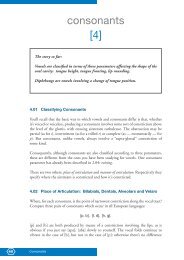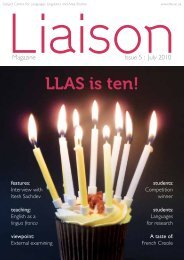PHONETICS MANUAL.indd - HumBox
PHONETICS MANUAL.indd - HumBox
PHONETICS MANUAL.indd - HumBox
You also want an ePaper? Increase the reach of your titles
YUMPU automatically turns print PDFs into web optimized ePapers that Google loves.
The symbol is referred to as “small capital i”. For languages like English and German<br />
which need [I] as well as [i], the latter can be referred to as “lower-case i” when clarity<br />
is required.<br />
[U]<br />
Read “upsilon”. It’s the mirror-image of [I] in the opposite corner of the vowel<br />
chart, being further forward and lower than back [u], which itself is slightly<br />
further forward and lower than Cardinal No. 8. Full [U] and fool [u] illustrate<br />
the difference in English; Fluß [U] and Fuß [u] in German.<br />
Fig. 20<br />
u (8)<br />
U<br />
o (7)<br />
Germanists should note a further symbol! English has two high vowels [i] and [u],<br />
each with a more central equivalent [I] and [U], as you’ve just seen. But German has<br />
three high vowels [i], [u] and [y], and, symmetrically enough, each of the three has<br />
a “centralized” equivalent [I], [U] AND [Y]. This last vowel (read “small capital y”)<br />
is found in many common words (fünf, müssen) and sometimes serves to distinguish<br />
pairs, e.g. hüte, with [y], and Hütte, with [Y]. Standard French, on the other hand,<br />
which lacks [I] and [U], also — not surprisingly — lacks [Y]. (But the latter, like [I]<br />
and [U], is used in Canada and Belgium.)<br />
[¡] This is sometimes used for the vowel of on, hot, lost (read “reversed italic a”).<br />
It’s actually the symbol for Cardinal 13. The English vowel in question is<br />
located between this and Cardinal 6 [O], so some transcribers prefer to use [O]<br />
for on, hot, lost, etc.<br />
[O:]<br />
[ˆ]<br />
This is Cardinal 6 with a length-mark (see 3.08) and the normal way of<br />
representing the vowel of horse, caught, lawn: [hO:s], [kO:t], [lO:n].<br />
“Turned v” is actually the symbol for Cardinal 14 (one of the back unrounded<br />
vowels you were told not to worry about in 3.05). The RP vowel found in<br />
words like up, butter, come is close enough to this for [u] to be used to represent<br />
it in transcriptions of English. Note it carefully: it’s a very common sound in<br />
RP, where put, with [U], is not at all the same thing as the golfing term putt,<br />
with [ˆ].<br />
These symbols are in general use for transcribing English. Less widely adopted is<br />
[ ] (“reversed open e”), which some phoneticians use for the vowel in her, girl, first,<br />
E<br />
30 Vowels






